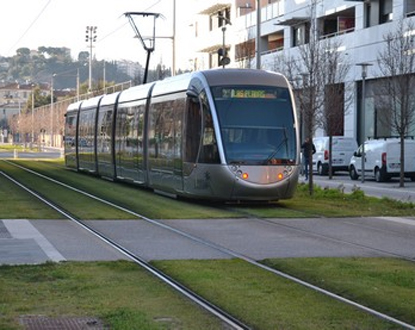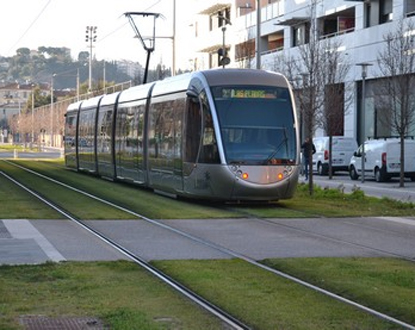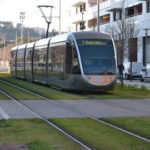The extension of line 1, from Pont Michel to Pasteur, is the first step in the implementation of the tramway network planned by the Nice Côte d’Azur transport scheme by 2030. With the tramway, the urban district of Pasteur and the lower part of the Cimiez hill benefit from better public transport service. This concerns more than 12,000 people living or working in this area.

Pont Michel/Pasteur: the 1st phase of the line 1 extension project
The “Pont Michel – Pasteur” extension will attract 5,000 additional daily travelers on line 1 of the tramway.
Thus, the total ridership of line 1 estimated in 2013 will reach 105,000 travelers per day.
The Roman Road
As the tramway exits the bridge, it enters the district by “sliding” into the heart of a landscaped area marked by rows of new trees.
The René Coty Bridge
The construction of a new bridge for the tramway is an opportunity to renovate the current bridge (guardrails, lighting, sidewalk, etc.).
Pont Michel
The pedestrian crossings around Collège Bon Voyage are maintained and secured.
Platform and development works
Focus on laying green tracks
The Metropolis Nice Côte d’Azur, as part of its strong commitment to a sustainable development policy, has worked with the project manager and companies to develop a technical solution adapted to laying grass on the tramway platform, which contributes to preserving biodiversity in urban environments.
The technique generally implemented on tramway lines in France is not very effective in maintaining grass in summer, mainly due to the thin soil layer (18 cm).
On the extension of line 1 between Pont Michel and Pasteur, the “augets” laying technique (COLAS RAIL process) was chosen. This involves using prefabricated concrete elements on which the tramway rails will be laid. This method preserves earth-to-earth contact between rails and tracks, thus lightening the structure and enhancing turf stability.
Laying on “augets” ensures a 40 cm layer of topsoil across the entire width of the tramway platform, which provides sufficient moisture and nutrients for the grass. An expected reduction in watering of about 30% is anticipated.
Platform construction and laying of rails on “augets”
The platform construction proceeds in four stages lasting approximately four months.
- The roadway is excavated to a width of about 6m and a depth of about 110cm for the future platform. A compacted backfill material is placed 50 cm deep.
- Prefabricated “augets” are positioned on the compacted ground.
- The rails are then positioned on the “augets”, and a bedding concrete is placed to secure the rail to the “augets”.
- Topsoil and grass are installed.
Simultaneously, the company will build concrete structures supporting the poles for the overhead contact line attachment. They will also construct the “tramway’s multitubular”, a sort of concrete “pipe” housing the electric cables and fiber optics necessary for the tramway’s operation.
Rail welding in all its glory
Welds are done using the aluminothermic process.
Aluminothermic welding refers to the technique used to join rails. It involves a mix of iron oxide and aluminum in a crucible that react together to generate a temperature of 2,000 °C.
- The mixture (Iron Oxides + Aluminum + Ferrous Alloys), in powder form in a crucible withstands high temperatures, is ignited.
- Through a chemical reaction, steel and fluid aluminum oxide are produced. Due to their significant density difference, the steel sinks to the bottom of the crucible, while aluminum remains on the surface.
- The steel thus obtained flows automatically at a temperature of about 2000°C into the mold covering the rail ends.
- These preheated ends then melt and join through the fusion steel.
- After a few minutes necessary for metal solidification, the mold is removed, and excess metal is cut off hot.
- The weld is then ground to ensure rail continuity, guaranteeing optimal rolling comfort. This last operation is carried out 24 hours after the welding operation.
Platform development work should be completed by October 2012.
COST
The cost of the tramway platform development work is €2,480,000 excluding taxes.
TRAFFIC
The impacts on traffic are as follows:
- Throughout the construction period, the south sidewalk of Pont Coty is closed. Pedestrians can only use the sidewalk on the north side. Four traffic lanes remain on Pont Coty.
- The Roman road is converted to one-way, from Avenue du Maréchal Lyautey to Rue Delvalle (detour via Rue Delavalle and Rue Gauthier Roux);
- The exit of Rue du Colonel Gassin onto the Roman Road is closed (detour via Rue Augusta);
- Access to Place Abbé Martelli is diverted by temporary access from the Turin road.
- Traffic on the Paillon artery remains open,
NOTE: Temporary parking (around thirty spaces) is restored on Boulevard Joseph Raybaud, now one-way.
The works
The service is scheduled to start in spring 2013.
The cost
The cost of the line 1 extension is €23.9 million including taxes.
Funded by Nice Côte d’Azur with the support of the Alpes Maritimes General Council, the State, the Provence-Alpes-Côte d’Azur Region, and the ERDF.



